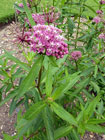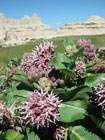The Milkweeds
Every so often in our researches we come across a plant with so many uses that we wonder why it has never been commercially exploited. One such group of plant - all of them ideal for the Permaculturalist - is the Milkweeds (Asclepias species) from North America. The genus Asclepias contains over a hundred species of mainly perennial herbs growing in temperate and topical regions. We will look at four of these species:-

|

|

|
.jpg)
|
- Asclepias incarnata Swamp Milkweed
Growing to 4ft in swamps, wet thickets and on shores.
|
- Asclepias speciosa Showy Milkweed
Growing to 2.5ft on prairies in sandy and loamy, usually moist soils.
|
- Asclepias syriaca Common Milkweed
Growing to 3ft in thickets, roadsides, dry fields and waste places
|
- Asclepias tuberosa Pleurisy Root
Growing to 2ft in dry, open soils.
|
All the above are fairly easy to grow preferring a rich light or peaty soil and a sunny position. A. icarnata is probably the easiest to grow and is the most adaptable to different soil types. They all succeed in most areas of Britain. The only real problem We have has in growing them is that young plants are very attractive to slugs who will totally decimate them. However, established and strong growing plants seem to be little affected.
Virtually all parts of these plants are edible when cooked though there are reports that large quantities can cause stomach upsets. The young shoots, gathered in April-May, can be used as an asparagus substitute whilst the younger parts of old shoots can be cooked like spinach.
Young flower buds have a delicious pea-like flavour as do the very young seed pods (before the seed floss is produced). The flowers are used as a flavouring and a thickener in soups and were also harvested in the early morning when dew was still on them and then boiled down to make a sugary syrup. In hot weather the flowers often produce so much nectar that it forms crystalline lumps. This can either be sucked or picked off the flowers and is a real delicacy. In our experience to date A. tuberosa is the most likely to do this. A. tuberosa, as the name suggests, also produces a tuberous root and this is edible when cooked, with a nutty flavour. The seed of all species are said to be edible raw but we have not tried them, they certainly do look very interesting.
All these edible qualities, though, are just one aspect of the plants uses, they have much more to offer. All the species produce a tough fibre in their stems. This can be used to make cloth, twine, etc and was traditionally harvested from the dead stems in autumn and winter, a fairly simple process. Dry summers produce the strongest fibres.
Mature seed pods contain quite large quantities of floss. This is a lovely white silky material with a number of applications. It can be used as a kapok substitute for stuffing soft toys etc, and being very water repellant, it has been used in life preservers where its buoyancy can keep a person afloat for days. Although difficult to spin on its own, it can be mixed with other fibres to make cloth and it has also been used for making candle wicks.
The plants also contains a latex which can be extracted and made into a good quality rubber. This latex is largely found in the leaves, is produced mainly in hot weather when grown on drier soils and is destroyed by frost. Concentrations vary and are considered to be too low for commercial exploitation. The latex has also been used as a chewing gum and regular applications are said to be a cure for warts.
The seeds contain up to 20% of an edible semi-drying oil. This oil can be used in making soap etc, though, since the seed is quite light, vast quantities of plants would need to be grown in order to obtain reasonable quantities of oil. The plants also have medicinal applications, for more details on these you should consult a good herbal such as 'A modern Herbal' by Mrs M Grieve.
Plants are very easily raised from seed, sown in a cold greenhouse from February to April. Seedlings should be potted up when quite young since they resent much root disturbance. Plant them out in their permanent positions in early summer and look out for slugs. If the plants have been well grown and are in vigorous growth then they are normally alright but any weaker plants are likely to disappear. We have had very little trouble with older plants. If done with great care, plants can be divided in spring when they come into active growth though We have not done this myself since seed is so easy.
One final thought - all of the above plant uses come from wild grown plants, there has been no attempt made, for example, to increase the latex content by selective breeding. We feel that there is vast potential with this group of plants and with many other species for improvements in yield, flavours, etc.
(You might also like to have a look at Milkweeds and Monarch Caterpillars a site with a lot of info about the plant and about the caterpillars which like them. )
Database
The database has more details on these plants: Asclepias incarnata, Asclepias speciosa, Asclepias syriaca, Asclepias tuberosa.